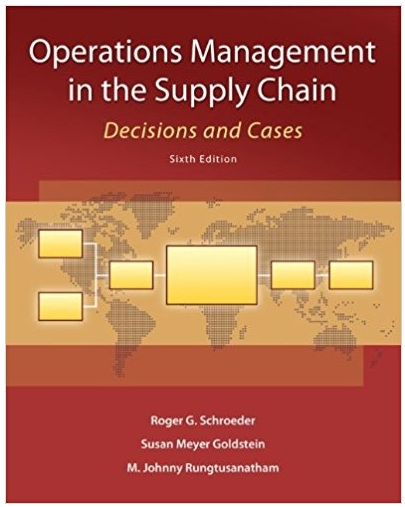Question
What 5 leadership approaches/theories indicating strengths and challenges of each perspective/theory to leadership effectiveness in the given scenario would you use? You may consider how
What 5 leadership approaches/theories indicating strengths and challenges of each perspective/theory to leadership effectiveness in the given scenario would you use? You may consider how the action in the case is viewed according to different theories/approaches, how different theories/approaches inform leadership opportunities or challenges in the case's action, how individuals in the case might improve their leadership by specifically understanding/applying a particular theory/approach, or the like. Your overarching goals are to 1) demonstrate a deep understanding of a minimum of 5 approaches/theories, 2) build well-constructed, thoughtful arguments demonstrating your ability to pose a good question and offer strong analysis, and 3) write well at a graduate level. It is an open-book, essay exam; you have the entire week to work on it. Your overall answer should be one solidly-constructed essay which includes an appropriate introduction, strong content development well-structured through the essay, and an effective conclusion.Make sure to discuss what each approach/theory says (show you understand it) before (or as) you are applying it to specifics within the case study.
The Power of Pride Case Study*
Many leaders rely on financial incentives to motivate followers. They believe that offering pay raises and performance bonuses is the best way to retain employees and to encourage them to work harder. Organizational consultant and researcher Jon Katzenbach argues that these leaders are mistaken. It is pride, not money, that builds institutions that deliver the best products and services along with superior economic performance.
Katzenbach acknowledges that there are some advantages of monetary rewards, including the fact that they are widely accepted and easily understood. However, Katzenbach is convinced that the disadvantages of financial incentives far outweigh their advantages. That's because:
- money attracts and retains better than it motivates excellent performance;
- money is effective only as long as the leader can pay more than the competition;
- money can promote behavior (delaying investments, booking earnings prematurely) that conflicts with the goals of the organization;
- money and titles are more motivating for top-level executives than frontline employees;
- money and ego are better at motivating individuals than teams or groups; and
- materialism encourages greed and other selfish behaviors.
Financial rewards foster self-serving pride. Those motivated by this kind of pride look for the biggest paycheck and the most recognition. They are quick to leave in an economic downturn. Institution-building pride, on the other hand, is intrinsic, promoting commitment to shared goals. This type of pride comes from doing something well and, when linked to organizational goals, produces energy and commitment. Those driven by intrinsic pride focus more on the organization's performance-customer satisfaction, product quality, respect of peers-than on themselves. Such pride comes from the results of their work (product quality, the type of work), how they work (values, standards, commitment), and with whom they work (colleagues and the organization).
Katzenbach points to the Marines, Home Depot, Aetna insurance, Hills Pet Nutrition, and pride. Their leaders follow one or more paths to fostering pride. The first path focuses on mission, values, and collective pride (MVP). The Marines, for example, are proud of their history, heroes, and values ("Do the right thing, in the right way, for the right reasons"). The second path emphasizes process and metrics. High-pride organizations involve followers in designing measurement instruments and provide constant feedback. The walls of Avon manufacturing plants are covered with charts and graphs, developed with employee input, that help workers track their progress. The third path nurtures entrepreneurial spirit. Peak performers are energized by the pride they feel in doing something new-developing a product or service, redesigning a process, or teaching out to additional customers. Ski instructors at Vail, for instance, operate as entrepreneurs, booking their own clients. They take pride in the development of their students. As a result, they stay over 10 years (much longer than the norm in the skiing industry). The fourth path fosters pride by providing lots of opportunities for individual growth and development. For example, inventors at 3M are rewarded for creating new products then taking them to market. The fifth pride-building path highlights recognition and celebration. Leaders in these cultures (such as Southwest Airlines) sponsor parties, friendly competitions, and celebrations.
Katzenbach believes that all leaders can learn to become institutional pride builders by following the example of the most effective "manager motivators." The best pride builders keep in mind that the journey is more important than the destination. They encourage followers to take pride in what they do every day and strive to create emotional commitment, not just cognitive compliance. These leaders realize that what works in one location may not work in another. They tie their efforts to local events and role models and reach outside the organization to build pride through family gatherings and community service. Finally, those who excel at pride building highlight a few key themes to link their efforts. They emphasize those themes by repeating the same important stories and keep the group focused on a few key indicators like safety, product quality, or customer service.
Step by Step Solution
There are 3 Steps involved in it
Step: 1

Get Instant Access to Expert-Tailored Solutions
See step-by-step solutions with expert insights and AI powered tools for academic success
Step: 2

Step: 3

Ace Your Homework with AI
Get the answers you need in no time with our AI-driven, step-by-step assistance
Get Started


